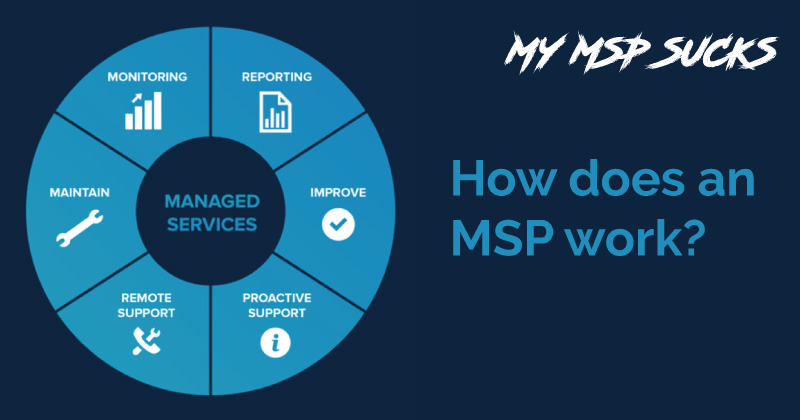A managed service provider (MSP) is a third-party organization that administers a customer’s IT infrastructure and end-user systems from a remote location. MSPs are hired by small and medium-sized businesses (SMBs), NGOs, and government organizations to provide day-to-day management services. Network and infrastructure management, security, and monitoring are examples of these services.
MSPs regularly handle administration services, allowing customers to focus on developing their services rather than worrying about prolonged system downtimes or service interruptions.
What is an MSP example?
According to Grand View Research, top MSP companies in the managed services market include Accenture, Fujitsu, IBM, Cisco Systems, Ericsson, Lenovo, DXC, and Hewlett Packard Enterprise Development.
Datacenter management, network management, mobility management, infrastructure management, backup and recovery management, communication management, and security management are the services provided by MSPs.
On the other hand, MSPs come in different shapes and sizes. The MSPAlliance, an international network of cloud and managed service providers, claims over 150,000 MSPs worldwide.

How does an MSP work?
When a managed service provider is hired to help an organization achieve its goals, it is frequently expected to fill a gap or play a function in the IT system or workforce. The MSP and the company’s communication usually start with an evaluation to determine the existing state of the organization. This evaluation may reveal areas where there is space for development and how to best support corporate objectives.
Because no one-size-fits-all solution exists for every business, an MSP may offer various service options. Technical assistance fix services and subscription services are two types of MSP offers.
- MSP technical support fix services mainly focus on remotely repairing or dispatching professionals to a company’s site to remedy difficulties. MSPs who offer this service charge the business for the time spent troubleshooting and any parts necessary to resolve the issue.
- MSPs that provide a subscription service model focus on an organization’s network’s quality of service and typically cost consumers on a monthly basis. As part of the agreement between the organization and the MSP, the MSP will resolve it if a problem emerges. The subscription model is based on pre-determined charges per computer or piece of equipment.
A Service Level Agreement (SLA) defines what the organization can anticipate from the MSP regarding maintenance, security, monitoring, reporting, and other services. The service agreement also includes response times, performance, and security criteria.
MSPs can supply their native services, services from other suppliers, or a hybrid of the two. Pure-play MSPs specialize in a single vendor or technology and provide their native services more often than not.
RMM Tools and PSA Applications
MSPs also concentrate on establishing specialized software platforms that manage functions automatically. Remote Monitoring Management (RMM) tools and professional services automation (PSA) applications are included in these platforms:
- Off-site personnel can use RMM software to maintain IT systems like networks, servers, workstations, and mobile devices. MSPs can also use these tools to apply patches and other system changes.
- An MSP can use PSA technologies to manage a company’s projects, billing, assets, and inventories.
A managed service provider’s service provision is frequently provided under an SLA, a contractual agreement between the MSP and its customer. The service level agreement (SLA) specifies the relationship’s performance and quality metrics. When agreeing on the commitments, they make in SLA contracts, organizations must be specific.
An SLA could be tied to a pricing mechanism used by an MSP. In a tiered pricing structure, an MSP might offer a variety of SLAs to customers, with the consumer paying a greater charge for higher service levels.
What does MSP offer?
An organization’s operations can be improved by hiring a managed service provider.
Small and medium-sized businesses (SMBs) are typical MSP clients. Because many smaller businesses lack in-house IT knowledge, they may see an MSP’s service offering as a method to acquire IT expertise. Larger businesses, on the other hand, may contract with MSPs. Government entities, for example, may hire an MSP to supplement their in-house IT employees due to financial constraints and hiring restrictions.
MSPs manage the complicated, time-consuming, or repetitive tasks of managing IT infrastructure or end-user systems. MSPs usually do the following tasks:
- Handle IT infrastructure management
- Provide technical help to employees
- Integrate cybersecurity technologies into IT
- Manage user access accounts
- Manage contracts
- Provide compliance and risk management
- and provide payroll services.
Conclusion
You can begin thinking about employing an MSP for your company now that you better understand what it is and the numerous features of MSPs. MSPs provide necessary services to businesses to keep their IT infrastructure running. Giving an MSP control of your network could be one of the best business moves you’ll ever make.
Do you better understand what MSP is and how it might help your company? Protected Harbor can provide you with the most significant IT and cybersecurity solutions. We take pride in the fact that we are not your average MSP. Our professional team goes above and beyond to ensure that our customers are satisfied. By partnering with Protected Harbor, you get access to the best cybersecurity, data backup, and disaster recovery services. Let us help you take your business to the next level today!




